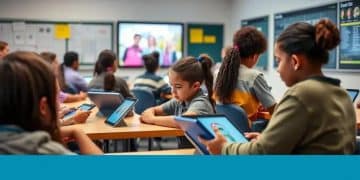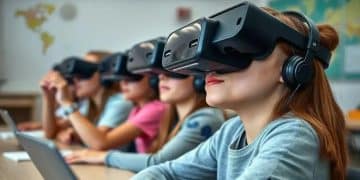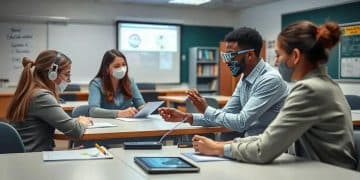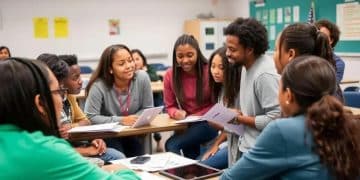Insights on digital literacy curriculum for modern learners
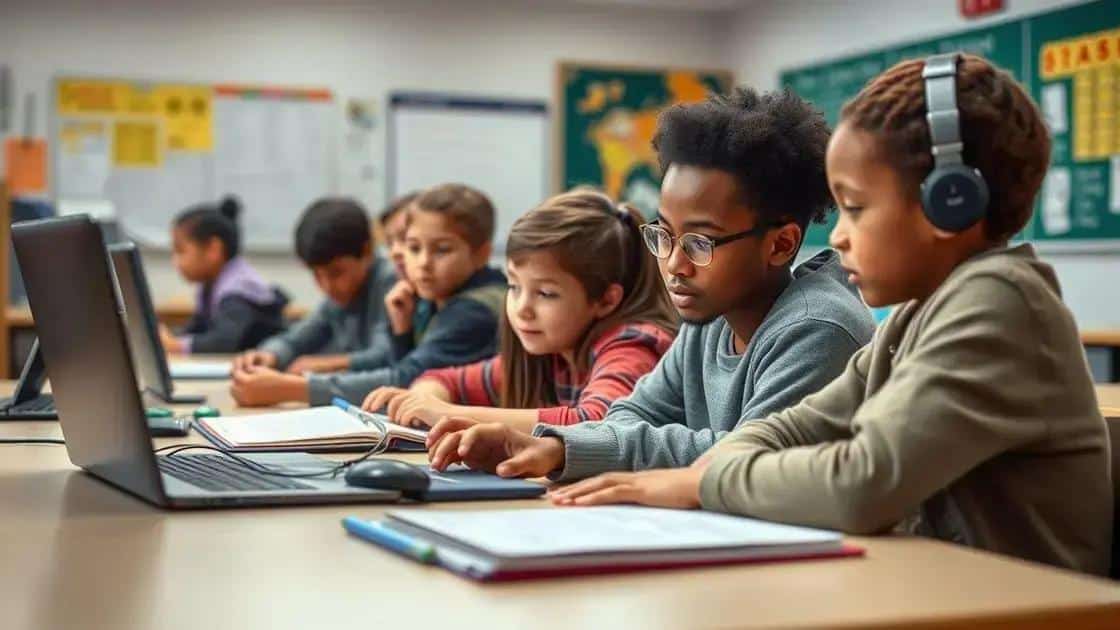
Effective digital literacy education incorporates innovative teaching strategies, ongoing assessments, and technology integration to equip students with essential skills for navigating a technology-driven world.
Insights on digital literacy curriculum are essential in today’s fast-paced, tech-driven society. It’s vital for students to navigate digital spaces effectively. So, how can educators ensure their students are prepared for this challenge?
Understanding digital literacy and its importance
Understanding digital literacy is essential for today’s students. It goes beyond basic computer skills, encompassing the ability to find, evaluate, and use information effectively. As technology evolves, the importance of these skills only increases.
Digital literacy involves various competencies that aid in navigating our information-rich world. It is about being able to critically assess online content, recognizing credible sources, and understanding how to protect personal information while online. The world of digital communication requires not just knowledge but also the ability to engage responsibly.
Key Components of Digital Literacy
Digital literacy can be broken down into several key components. Understanding each is vital for both educators and students.
- Information Literacy: The ability to locate and evaluate information.
- Media Literacy: Understanding how media works and its impact on society.
- Technical Proficiency: Knowing how to use various digital tools effectively.
- Online Safety: Awareness of cybersecurity and how to protect oneself online.
Digital literacy plays a critical role in educational success and future job opportunities. As we shift more into a digital economy, these skills become necessary for all fields. Educators must integrate digital literacy into the curriculum, ensuring students are not only consumers of information but also critical thinkers.
Moreover, fostering a strong sense of digital citizenship is crucial. This includes understanding the ethical use of technology and engaging respectfully in online communities. Encouraging students to explore, create, and collaborate online can enhance their learning experience.
In summary, without a strong foundation in digital literacy, students may struggle to navigate their future in an increasingly digital world. This understanding empowers them to use technology responsibly and effectively.
Key components of an effective digital literacy curriculum
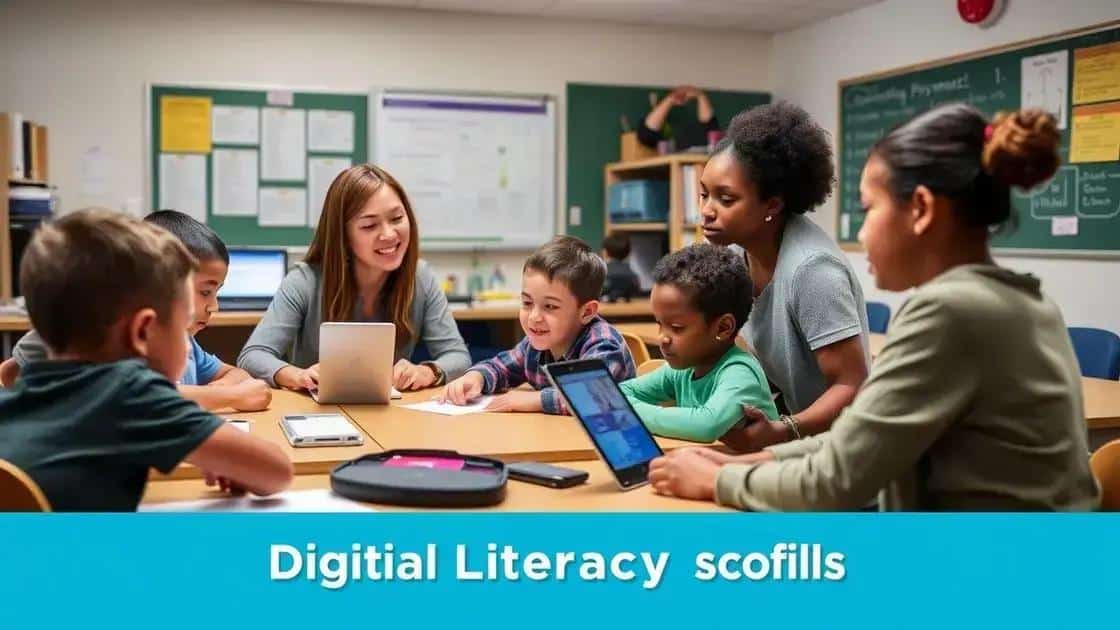
To create a successful digital literacy curriculum, it’s vital to include several key components. Each of these components helps build a comprehensive framework that supports students in becoming adept digital users.
Core Areas of Focus
First, the curriculum should address core areas that encompass essential skills. Strong emphasis on these areas prepares students for real-world applications.
- Information Seeking: Teach students how to find reliable information online.
- Critical Thinking: Encourage analysis of digital content to determine its validity.
- Communication Skills: Foster effective communication through digital platforms.
- Technical Skills: Equip students with the ability to use various software and tools.
Additionally, ethical considerations must be integrated into the curriculum. Students should understand the importance of respecting copyright, citing sources, and maintaining privacy online. This foundation helps to cultivate responsible digital citizens.
Adaptability is another crucial element. The digital landscape is always changing, and the curriculum must evolve with new technologies and trends. Regular updates and feedback will ensure that the content remains relevant and engaging.
Assessment and Evaluation
Assessment strategies play a role in measuring student progress. Using a combination of formative and summative assessments can provide insights into how well students are grasping the material. Examples include quizzes, project presentations, and online collaborations.
Incorporating real-world scenarios is also productive. By engaging students in projects that require real-life applications of their skills, educators can enhance the learning experience. This method fosters deeper understanding and retention of knowledge.
In summary, building an effective digital literacy curriculum requires attention to multiple components. By focusing on key areas, promoting ethical use, ensuring adaptability, and implementing strong assessment strategies, educators can empower students for a successful future.
Innovative teaching strategies for digital literacy
Innovative teaching strategies play a crucial role in enhancing digital literacy among students. By employing creative methods, educators can engage students actively and motivate them to develop essential skills.
Project-Based Learning
One effective approach is project-based learning, where students work on real-world problems. This strategy encourages collaboration and critical thinking as students navigate digital tools to find solutions and present their findings.
- Students can create a digital magazine or blog.
- They may develop a website to address a local community issue.
- In groups, they can produce videos that showcase their understanding of a topic.
- Using social media for storytelling can also enhance their communication skills.
Furthermore, gamification can transform traditional lessons into interactive experiences. Incorporating game mechanics into exercises boosts motivation and helps students retain information better. Through challenges and rewards, learners can enhance their digital skills in a fun way.
Flipped Classroom Model
The flipped classroom model is another innovative method. In this approach, students learn new content at home through videos and online resources. Class time is then dedicated to hands-on activities and discussions.
This method fosters a deeper understanding of digital literacy as students apply what they’ve learned. They can work on projects, collaborate on tasks, and receive immediate feedback from peers and teachers.
Moreover, incorporating technology tools such as interactive quizzes and discussion forums can create a dynamic learning environment. Students can engage with each other, share ideas, and develop their skills in real-time.
Finally, integrating multimedia resources into lessons can cater to different learning styles. Videos, podcasts, and infographics make learning more accessible and enjoyable. This variety keeps students interested and helps them grasp complex concepts more easily.
Measuring success in digital literacy education
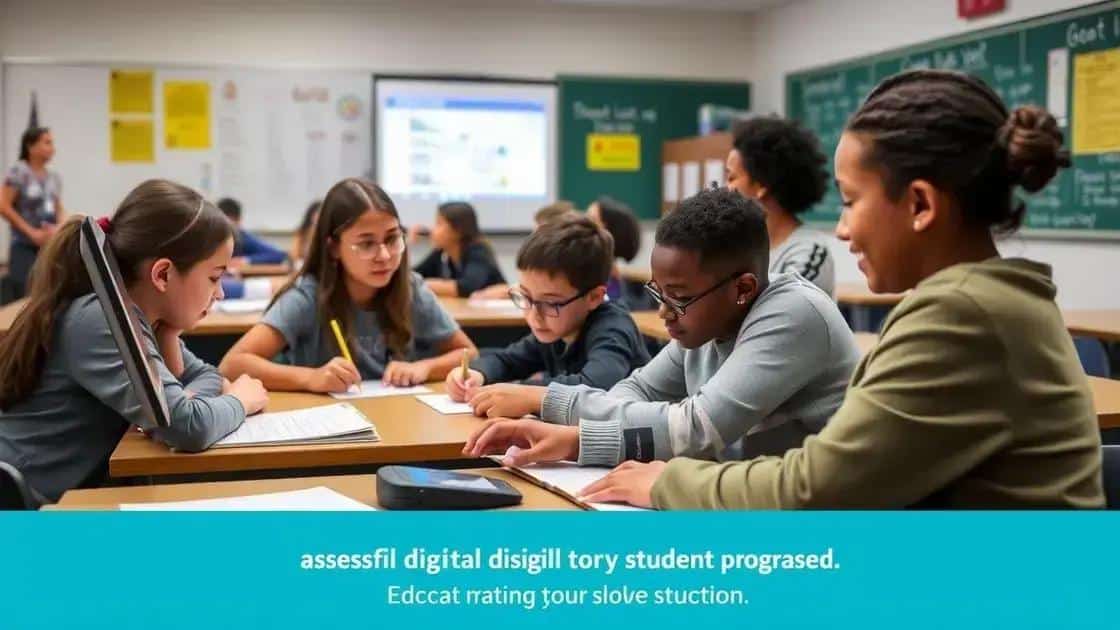
Measuring success in digital literacy education is essential to understand how effectively students are learning and applying their skills. With the right strategies, educators can evaluate student progress and adjust their teaching methods.
Assessment Techniques
Various assessment techniques can provide insights into student performance. These techniques can range from formal tests to informal evaluations that capture their skills in real-time.
- Formative Assessments: These ongoing evaluations help teachers monitor student understanding during the learning process. Examples include quizzes, reflections, and class discussions.
- Summative Assessments: At the end of a unit, summative assessments measure how much students have learned. Projects, presentations, and end-of-term exams fit this category.
- Self-Assessment: Encouraging students to evaluate their skills can help them take ownership of their learning. Tools like surveys and checklists can guide this process.
- Peer Assessment: Allowing students to review each other’s work promotes collaboration and communication, enhancing their understanding of digital technologies.
Gathering data through these assessments is crucial. This data can help inform instruction, ensuring that all students receive the support they need to succeed.
Using Technology for Evaluation
Technology plays a significant role in measuring digital literacy outcomes. Online assessment tools can streamline the evaluation process, making it easier to track student progress over time.
Additionally, data analytics can highlight trends in learning, helping educators identify areas where students struggle. With this information, teachers can adapt their curriculum and teaching strategies accordingly.
Furthermore, incorporating real-world applications into assessments allows students to demonstrate their skills in meaningful contexts. For instance, having students create a digital project that addresses a community issue not only shows their digital literacy proficiency but also engages them in active learning.
Ultimately, successful measurement in digital literacy education relies on a combination of various assessment methods and the effective use of technology. By thoughtfully analyzing student performance and providing timely feedback, educators can foster continuous improvement and ensure that all students develop the digital skills necessary for their futures.
FAQ – Frequently Asked Questions about Digital Literacy Education
Why is digital literacy important for students?
Digital literacy is crucial as it equips students with the skills needed to navigate a technology-driven world, enhancing their learning and career opportunities.
What are effective teaching strategies for digital literacy?
Innovative methods include project-based learning, gamification, and the flipped classroom model to engage students and foster critical skills.
How can we assess student progress in digital literacy?
Using formative and summative assessments, along with self and peer evaluations, helps measure student understanding and growth in digital skills.
What role does technology play in measuring digital literacy?
Technology tools facilitate efficient assessments, allowing for real-time feedback and data analytics to track student performance and enhance learning.

